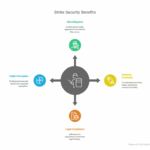With the current COVID-19 epidemic, businesses have had to examine their operations and ask themselves, “DO WE HAVE COVERAGE IF ONE OF OUR EMPLOYEES IS OUT OF THE OFFICE FOR AN EXTENDED period?” Companies of all sizes have had to devise contingency plans for their employees if they are unable to report to work due to illness, the need to care for a sick loved one, or the need to care for children who are stranded at home due to school and daycare closures for an extended period of time. When you consider how much money organizations save on the front end during the hiring process, the contingent labor trend is unsurprising. However, there are several other compelling reasons why modern businesses should embrace diverse contingent labor solutions.
SAFETY: It’s no secret that the job market in the United States is booming right now. Unemployment is at an all-time low, and everyone appears to be hiring. However, how stable is it? Having contingent workers on your payroll allows you to adjust the size of your team based on how much business is coming in.
You pay for the work: In business, there is always a slowdown in production at some point during the year. Nobody appears to be working, and you’re paying your employees to appear to be working but not doing so. Having a contingent workforce allows you to pay your employees according to the amount of work they do.
If a large project comes in the door, hiring contingent workers based on project size allows you to pay them until the project is completed, then break connections with them when activity slows down.
Buys you time: Contingent labor can be used as a transitional stopgap. A specialist can come in and take over the job of a departing employee. They can work as you look for a successor who is more committed to staying with your firm in the long run.
Low-risk game: Contingent workers aren’t considered formal employees, so they don’t have the same rights to a severance payment if they’re fired. If you hire someone for a specific project and it doesn’t work out or your project is over, you can easily cut ties without breaking the bank.
Budget-friendly: Having the correct contingent workforce strategy will help you save money during the hiring process. You won’t have to pay a lot of money to hire and train a new employee. Instead, you’ll have access to a pool of professionals who are available to work. You also don’t have to provide the same benefits to contingent workers as you do to full-time or part-time employees. Here is a list of areas where using contingent labor rather than full-time staff will save you money.
- Health insurance
- Paid sick/vacation days
- Retirement plans
- Administrative hours related to onboarding
- Unemployment claims
Specialized hires: For specialized sectors, some contingent workers are specialists in a specific field or subject. They come to you with a clear understanding of the tasks they will be assigned. This allows you to integrate them easily into projects while also saving your manager time by eliminating the need to teach them certain skills and processes.
More time for others: If you and your team aren’t prepared to lose a team member, you may find yourself rushing to keep up when someone’s 8 hours per day are removed from the equation. Other team members may be called in to assist, making them less effective on the tasks for which they were employed. Too many responsibilities can be stressful for employees; therefore, it’s best to close the gap as soon as possible. Contingent workers enable you to accomplish just that while also reducing the amount of stress placed on other team members.
Flexibility: Depending on the sector, some contingent workers may be able to work outside the office. This provides flexibility in several areas.
Logistical concerns are no longer an issue. You won’t have to worry about where they’ll sit in the office or where they’ll park. They will have their laptop and will be able to work from any place with a Wi-Fi connection.
Businesses can stay linked using online project management solutions without having to speak to each other face to face. Contingent workers are used to using internet technologies to communicate and complete jobs. They can also provide you with their billable hours and proof of what they worked on, even if they are thousands of miles away.
Formulation of Contingent workforce strategy
Each company is unique. A 50-employee startup or a multibillion-dollar multinational faces distinct obstacles than a small mom-and-pop shop. The trick is to figure out what’s best for your firm.
Consider using a staffing agency to help build your strategy and fill your vacancies if your organization has decided to start hiring contingent workers.
RSS INC. offers the experience you need to fill roles requiring specialized knowledge and abilities. Each candidate goes through a thorough vetting process as part of our staffing services, so you can rest assured that your contingent hiring will fit seamlessly into your overall plan.
Find out more about our staffing services and how we can help your company keep up with the contingent workforce trend.








